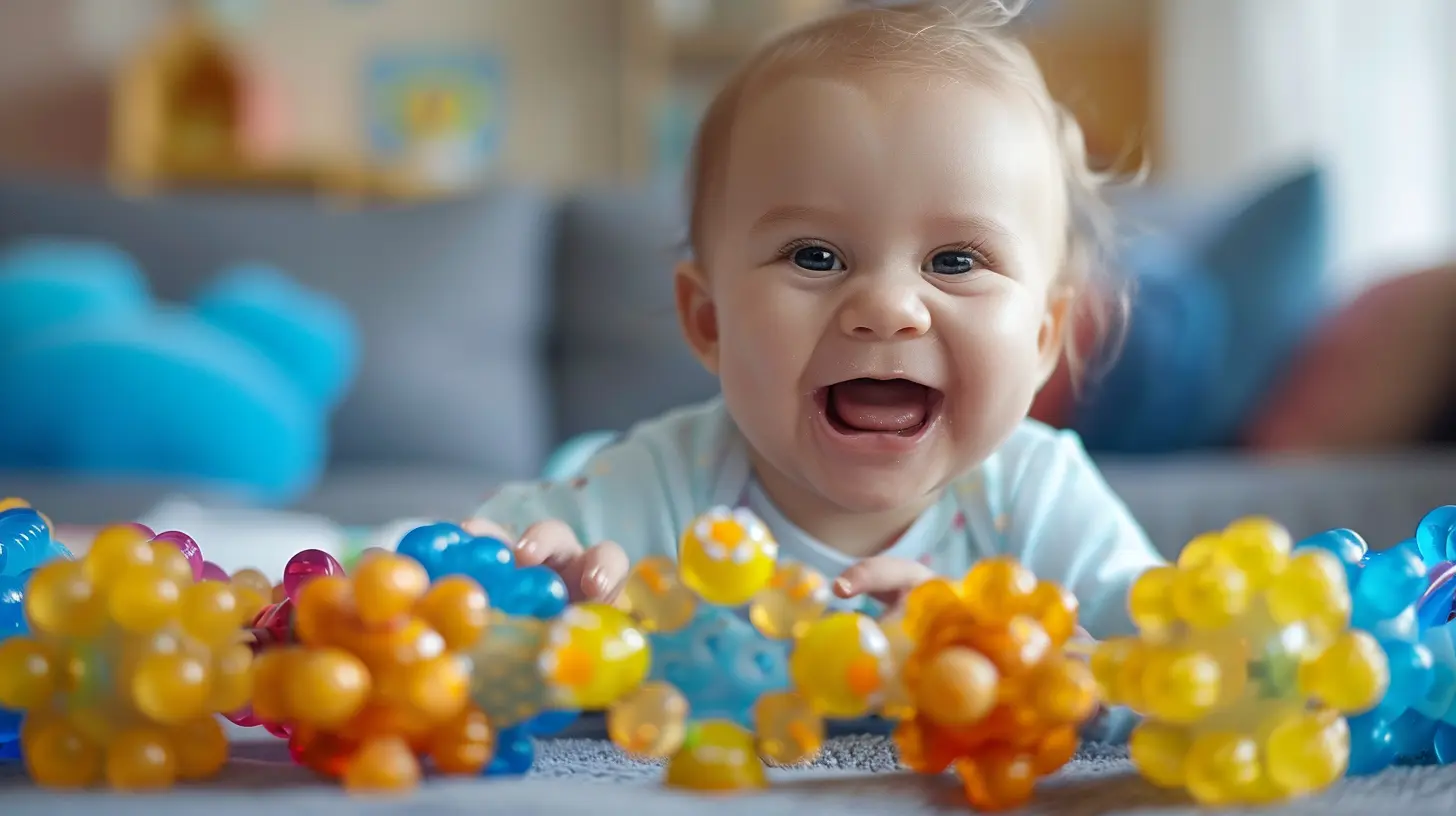Understanding Your Baby’s Teething Symptoms
15 September 2025
Let’s talk teeth. Or rather, the absence of them… and the tiny terror that erupts when your sweet, smiling baby suddenly morphs into a drool-soaked piranha. Welcome to teething — a bizarre phase of parenthood filled with mystery, mayhem, and loads of bibs. If you’ve got a baby who seems to be chewing on anything that comes within a one-foot radius, you’re probably asking yourself: “Is it teething, or are they just trying out for the baby Olympics in gnawing?”
Well, you’re in luck. We’re diving deep into the wacky world of baby teething symptoms — the real ones, the weird ones, and the ones that’ll make you question your sanity. Grab a coffee (you’ll need it), and let’s decode this baby milestone together.
What Is Teething, Anyway?
Teething is what happens when your baby’s teeth start making their grand entrance through the gums. Think of it as your baby’s first taste of pain... and yours too. It usually starts somewhere between 4 and 7 months old, but like everything with babies, there’s no hard-and-fast rule.Some babies are born practically ready to chomp on a steak (not recommended), while others won’t show a single tooth until after their first birthday. Either way, when those little pearly whites start moving, you’ll know. Trust me.
Common Teething Symptoms (a.k.a. Are You Kidding Me?!)
Let’s cut to the chase. You’re here because your baby is acting “off,” and Google told you it might be teething. But what does teething actually look like in real life? Spoiler alert: it’s not just cute little teeth poking through.1. Drool. All. Day. Long.
If your baby is soaking through onesies faster than a frat boy at a water balloon fight, welcome to the drool club. Excessive drooling is the hallmark of teething. It’s their body’s way of lubing up the gums for those incoming chompers. Get the bibs ready and maybe invest in a few beach towels.Pro Tip: Too much drool can lead to a drool rash on their chin, neck, or chest. Keep the area dry and slap on some baby-friendly balm.
2. Chewing Like a Maniac
Furniture legs. Your fingers. The dog’s tail. Everything’s fair game when your baby is teething. Chewing helps relieve the pressure from under the gums, so don’t take it personally when your baby starts using you as their human teething ring.Survival Tip: Stock up on teething toys before they decide your phone is a delicious snack.
3. Crankiness That Rivals a Toddler Without Snacks
One minute they’re giggling. The next, they’re screaming like you dressed them in the wrong shade of pastel. Teething pain comes and goes, which means your sweet cherub might have sudden mood swings that make absolutely zero sense. Welcome to the ride.Translation: It’s not you. It’s the teeth.
4. Trouble Sleeping (For Both of You)
You thought that bedtime routine you nailed down was solid, huh? Think again. Those sore gums don’t clock out. Teething pain can strike in the middle of the night, turning your kid into a wide-eyed banshee and you into a coffee-fueled zombie.Real Talk: You might need to bribe yourself with snacks to get through this phase.
5. Refusing to Eat
Yes, even the baby who usually screams between spoonfuls of mashed bananas may suddenly refuse to eat. Sucking on a bottle or nursing can make sore gums feel worse. Sometimes cold food helps. Other times, nothing works. Babies are complex like that.What Can You Do? Try chilled purees or teethers stored in the fridge. Bonus points if it’s something they can hold themselves (hello, independence!).
6. Ear Pulling and Cheek Rubbing
Weird, right? But totally normal. The pain from the gums can radiate to the ears or cheeks, especially for those top molars coming in. So if your baby’s making themselves into a contortionist, it might be teeth… or maybe they’re just discovering their ears.Heads Up: If the ear-pulling is paired with a fever or cold symptoms, check in with your pediatrician. Better safe than sorry!
Less Common (But Totally Real) Symptoms
1. Slight Fever
Here’s the thing: teething might cause a low-grade fever, but that 102°F spike that has you panicking? That’s probably something else. Don’t blame everything on teething. Trust your gut and monitor closely.2. Diaper Rash
Too much drool often means extra saliva in the tummy and looser poop (yep, we’re going there). Hello, rash! Keep diaper cream close and don’t skip the wipes.3. Coughing and Gagging
There’s so much drool, it’s practically a flood. Babies sometimes gag on it or have a light cough. It’s usually harmless. But again — if this sticks around or seems intense, check with a doctor.
What Teething Isn’t
Let’s bust a few myths, shall we?- High Fever: Not a typical sign of teething. If the thermometer reads above 100.4°F, it’s probably something else.
- Runny Nose and Cough: Teething isn’t contagious, so don’t blame it for cold symptoms. If your baby’s got boogers and a barking cough, it might be a viral party instead.
- Explosive Diapers: While poop might get a little looser, full-on diarrhea is not considered a classic sign of teething. If it’s more than just “suspiciously mushy,” call the doc.
When Do Teeth Actually Show Up?
Here’s a quick cheat sheet, though remember — every baby sets their own schedule:| Tooth Type | Age Range (Months) |
|--------------------|--------------------------|
| Bottom front teeth | 6–10 |
| Top front teeth | 8–12 |
| Top side teeth | 9–13 |
| Bottom side teeth | 10–16 |
| First molars | 13–19 |
| Canines | 16–22 |
| Second molars | 23–33 |
Yes, that means you could be dealing with teething symptoms on and off for two years. Don’t shoot the messenger.
How to Help Your Baby Survive (and Keep Your Sanity)
Now that we’ve covered the symptoms, let’s look at what actually helps.1. Teething Toys
Silicone teethers, wooden rings, rubber keys — there’s a whole buffet out there. Just make sure they’re non-toxic and easy to clean. Bonus if they make fun sounds or textures.2. Cold Comforts
Chilled (not frozen!) teething rings, cold washcloths, or even a refrigerated spoon can work wonders. Think spa day for the gums.3. Gently Massage Their Gums
Wash your hands — seriously, every single time — and use your finger to rub their gums. They might hate it... until they love it. Babies are fickle like that.4. Try Teething Gels (With Caution)
Natural gels can be soothing, but steer clear of anything with benzocaine or belladonna. Your pediatrician will be your BFF here — always check first.5. Distraction Is Your Secret Weapon
Soothe the soul with cuddles, tickles, and their favorite lullaby (even if it’s sung off-key). Sometimes they don’t need a cure — just comfort.When Should You Worry?
Most teething symptoms are annoying but harmless. HOWEVER, if your baby has:- A persistent high fever
- Diarrhea
- A rash that spreads
- Extreme fussiness for days on end
- Ear tugging paired with a fever or pus
…it’s time for a little doctor date. Better to find out it’s nothing than miss something big.
Final Thoughts: Teething Is a Rite of Passage (For Parents Too)
Okay, real talk: teething is brutal. On your baby. On your nerves. On your laundry machine, which is now working overtime thanks to the tsunami of drool. But like all things baby-related, this too shall pass – hopefully without chew marks on your remote control.Remember, your baby isn’t actually turning into a mini vampire or an emotional wreck — they’re just trying to figure out why their face hurts and their mouth feels weird. And you? You’re the superhero helping them through it (while secretly Googling “Why is my baby trying to bite my elbow?” at 3AM).
So throw on a fresh shirt (because we know the one you’re wearing is soaked), and know that you’ve got this. Those teeth will show up eventually. And someday — you’ll miss the toothless grins and gummy smiles.
Just maybe not the drool.
all images in this post were generated using AI tools
Category:
Teething BabyAuthor:

Kelly Snow
Discussion
rate this article
1 comments
Myles Myers
Teething can feel like a whirlwind of sleepless nights and extra cuddles! It's amazing how such tiny teeth can cause such big changes. Remember, you're not alone in this journey. Embrace the chaos, trust your instincts, and don’t hesitate to lean on fellow parents for support. We're all in this together!
September 22, 2025 at 3:49 AM

Kelly Snow
Thank you for your supportive words! Teething can indeed be a challenging time, but knowing we're all in this together makes it a bit easier.


